MAINE, USA — Editor’s note: You are hearing the term ‘flattening the curve’ as a way to stem the tide of coronavirus cases. The above video explains what that means.
Summer is here and businesses are reopening, but we’re still in the midst of a pandemic. In the U.S. there are more than 2 million total cases of COVID-19, and more than 115,000 people have died with the virus. Thousands of new cases are being identified daily as states continue to reopen. Twenty-three states saw case increases over the last 14 days.
And while it’s important to support your local economy and resume some daily activities, it’s also important to make sure you’re safe while doing so.
Although there is no way to ensure zero risk of infection, the U.S. Centers for Disease Control and Prevention (CDC) says it’s important to understand the potential risks and how to adopt different types of prevention measures to protect yourself and to help reduce the spread of COVID-19.
So, the CDC is sharing some helpful tips and things to consider before venturing out.
The basics: If you have symptoms consistent with COVID-19 or have been in close contact with someone who has COVID-19, stay home and stay away from other people. If you have to go out, follow CDC recommendations.
In general, the CDC says the more closely you interact with others, and the longer that interaction is, the higher the risk of spreading COVID-19.
Here are some things to consider:
How many people will you interact with?
- Interacting with more people raises your risk.
- Being in a group with people who aren’t social distancing or wearing cloth face coverings increases your risk.
- Engaging with new people (e.g., those who don’t live with you) also raises your risk.
- Some people have the virus and don’t have any symptoms, and it is not yet known how often people without symptoms can transmit the virus to others.
Can you keep 6 feet of space between you and others? Will you be outdoors or indoors?
- The closer you are to other people who may be infected, the greater your risk of getting sick.
- Keeping distance from other people is especially important for people who are at higher risk for severe illness, such as older adults and those with underlying medical conditions.
- Indoor spaces are riskier than outdoor spaces where it might be harder to keep people apart and there’s less ventilation.
What’s the length of time that you will be interacting with people?
- Spending more time with people who may be infected increases your risk of becoming infected.
- Spending more time with people increases their risk of becoming infected if there is any chance that you may already be infected.
Ask yourself questions before deciding to go out to determine the level of risk:
- Is COVID-19 spreading in my community?
- What are the local orders in place?
- Will my activity put me in close contact with others?
- Am I considered at risk for severe illness?
- Do I live with someone who is at risk?
- Do I practice everyday preventive actions?
- Will I have to share any items, equipment, or tools with other people?
- Will I need to take public transportation?
- Does my activity require travel to another community?
- If I get sick with COIVD-19, will I have to miss work or school?
- Do I know what to do if I get sick?
If you decide to go out, continue to practice social distancing, wear a face covering, cover coughs and sneezes, wash your hands, and clean and disinfect frequently touched surfaces.
Click here for CDC guidelines for running errands.
Things to have on hand when going out:
- Cloth face covering
- Tissues
- Hand sanitizer (with at least 60% alcohol if possible)


Tips for dining at a restaurant:
- Check the restaurant’s website and social media to see if they have updated their information to address any COVID-19 safety guidelines.
- Before you go to the restaurant, call and ask if all staff are wearing cloth face coverings while at work.
- Wear cloth face coverings when less than 6 feet apart from other people or indoors.
- Take precautions – like wearing a cloth face covering as much as possible when not eating and maintaining a proper social distance if you are dining with others who don’t live with you.
- Ask about options for self-parking to remove the need for a valet service.
- Maintain a social distance of 6 feet or more in any entryway, hallway, or waiting area.
- Wash your hands for at least 20 seconds when entering and exiting the restaurant. If soap and water are not readily available, use a hand sanitizer that contains at least 60% alcohol. Cover all surfaces of your hands and rub them together until they feel dry.
- When possible, sit outside at tables spaced at least 6 feet apart from other people.
- When possible, choose food and drink options that are not self-serve to limit the use of shared serving utensils, handles, buttons, or touchscreens.
- Before using the restroom, make sure there is adequate soap and paper towels or hand sanitizer containing at least 60% alcohol.


Tips for going to the gym or fitness center:
- Use options for online reservations and check-in systems when available.
- Look for any extra prevention practices being implemented by the facility, such as new plexiglass barriers, staff wearing cloth face coverings, and closing of shared locker room space.
- Seek facilities with outdoor space or options for virtual classes and training sessions as much as possible.
- Limit attendance at indoor group training sessions. If you do attend such a session, maintain as much distance as possible between yourself and other individuals, and use cloth face coverings if they do not interfere with your activity. If you need to be indoors, open windows to increase airflow throughout the space.
- Maintain at least 6 feet of separation as much as possible in areas that may lead to close contact (within 6 feet) among other people, such as weight rooms, group fitness studios, pools and saunas, courts and fields, walking/running tracks, locker rooms, check-in areas, parking lots, and routes of entry and exit.
- Ensure equipment is clean and disinfected. Wipe down machines and equipment with disinfecting wipes and use hand sanitizer that contains at least 60% alcohol before using machines.
- Do not share items that cannot be cleaned, sanitized, or disinfected between use, such as resistance bands and weightlifting belts.
- Don’t shake hands, give high-fives, do elbow bumps, or touch others because close contact increases the risk of acquiring COVID-19.
- Be prepared that locker room access may be limited to the restroom area only, prohibiting the use of shower and changing areas.
Tips for traveling overnight:
- Use options for online reservation and check-in, mobile room key, and contactless payment.
- Before you go, call and ask if all staff are wearing cloth face coverings at work.
- Look for any extra prevention practices being implemented by the hotel, such as plexiglass barriers at check-in counters, and physical distancing signs in the lobby.
- Ask if the hotel has updated policies about cleaning and disinfecting or removing frequently touched surfaces and items (such as pens, room keys, tables, phones, doorknobs, light switches, elevator buttons, water fountains, ATMs/card payment stations, business center computers and printers, ice/vending machines, and remote controls).
- Wear a cloth face covering in the lobby or other common areas.
- Minimize use of areas that may lead to close contact (within 6 feet) with other people as much as possible, like break rooms, outside patios, inside lounging areas, dining areas/kitchens, game rooms, pools, hot tubs, saunas, spas, salons, and fitness centers.
- Request contactless delivery for any room service order.
- Consider taking the stairs. Otherwise wait to use the elevator until you can either ride alone or only with people from your household.
- If you are considering cleaning your travel lodgings, see CDC’s guidance on how to clean and disinfect.
- Visit CDC’s travel website for more information when planning trips.
For more tips and guidelines from the CDC, click here.
--
At NEWS CENTER Maine, we’re focusing our news coverage on the facts and not the fear around the illness. To see our full coverage, visit our coronavirus section, here: /coronavirus
NEWS CENTER Maine Coronavirus Coverage

